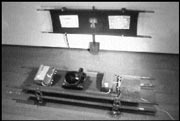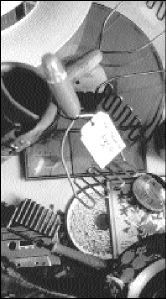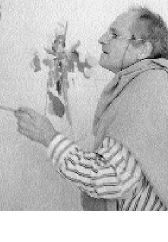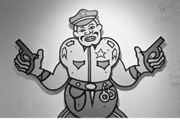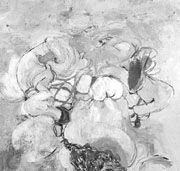2001 PACIFIC NORTHWEST ANNUAL EXHIBITION
Bellevue Art Museum, 510 Bellevue Way N.E. 425-519-0770, $6 10 a.m.-5 p.m. Tues.-Sat.; 10 a.m.-8 p.m. Thurs.; noon-5 p.m. Sun. ends Sun., Jan. 6
A LITTLE OVER a year ago, in my “Fall Arts Preview” (Sept. 7, 2000), I predicted the demise of the traditional museum format, asserting that given the entertainment-driven sensibilities of the new millennium and the drastically shortened attention spans of the television-fed multitudes, art merely hanging on walls was no longer enough. “People crave spectacle, they want interactive consoles, virtual reality, and multimedia stations with all the visceral, visual, and tactile stimuli of the fast-paced entertainment world, all neatly packaged and user-friendly,” I wrote. Since then—thankfully—I’ve been proven wrong time and again, as exhibitions of plain old paintings (John Singer Sargent’s luscious portraits at the Seattle Art Museum, for example) and cool new paintings—as well as drawings, prints, photographs, and other two-dimensional works—have continued to draw record numbers to museums and galleries in Seattle, charming jaded art devotees and first-time museumgoers alike.
On the flip side, the brashness of my prophecies has been somewhat vindicated by this year’s Pacific Northwest Annual Exhibition at Bellevue Art Museum. The Annual is a snapshot of the art being produced in the Pacific Northwest and British Columbia today, and the picture is one of experimental art that not only challenges the 2-D format but also avoids the slavish trendiness inherent in that risky enterprise. Of the 41 artists in the show, only a handful work in just two dimensions and only two of those are painters.
All this is not intended as a coy “I told you so,” or evidence that I singlehandedly surmised the future of contemporary art. No, the trend was already in full swing elsewhere before I caught on. The Annual simply illustrates that artists in the Northwest are keeping pace just fine—a real feat, considering that when Seattle yawns and rolls out of bed every morning, New York is already eating lunch, Europe is clinking cocktail glasses, and Japan is living in tomorrow. It’s refreshing to see that this year Seattle’s advancing the clock forward more than ever and producing work that goes beyond a mere superficial mimicry of the latest fads.
THIS YEAR’S Northwest Annual juror, Sue Spaid, a former Los Angeles art dealer and currently a curator at the Contemporary Arts Center in Cincinnati, had the daunting task of reviewing 4,500 slides submitted by 733 artists, none of whom she’d ever heard of. “Jurying such an exhibition is less about selecting the best works and more about choosing the most challenging works,” she insists. Spaid divides audiences into two categories: zealots and zombies. Zealots, she explains, are those willing to spend time really thinking about artwork, contemplating and analyzing it. Zombies are those among us whose limited attention span requires a more active, physical engagement.
A few works in the show cater to both crowds. In Dean Hudson’s installation (Untitled, 2001), a “how-to” video, elaborate labeling, and exacting diagrams walk the viewer through the construction and assembly of a shoddy 1970s interior, replete with cheap wood paneling and the “authentic” accouterments of a Hawaiian surfer dude. Hawaiian music wafts through the air as one learns exactly where to pound in the nail on which to hang dried leis (included), where to place flip-flop shoes, an opened beer bottle, and surfing magazines. The intrinsic message seems to be: You too can be chill; just buy this easy kit and a carefree existence can be crafted in your own home! The strength of this piece is in the meticulous documentation of absurdity piled upon absurdity. It’s a zealot’s guide to zombieness.
Juniper Shuey’s Myth is a video depicting a person playing in sand that is projected onto a real pile of beach sand heaped on the gallery floor. The viewer is forced to reconcile the tactile reality of this combination with the visual tricks that it plays. Jennifer West uses video projection to transform stalls in the bathrooms into interactive installations that amplify users’ sounds— tinkling, farting, and flushing. R. Eugene Parnell’s Your Island is an interactive CD-ROM that shapes a personalized island for each viewer based on answers to a series of questions. And there’s even a virtual reality installation, though it’s disappointing.
Even the more traditional works in the Annual are far from static. Sculptures are no longer self-contained entities that sit neatly on pedestals. Matthew Picton’s Sculptural Drawing, Cracked Parking Lot #2, for example, sprawls upwards organically, and Jack Daws’ Nike Branding Iron eerily implies a ghastly performance while poking fun at corporate branding. As always, Donnabelle Casis’ tortured drawings illicit an intensely visceral response.
Ironically, my absolute favorite piece at the Annual is the one showcasing all the art that didn’t make it into the exhibit. Salon des Refus鳼/I>, an extremely clever collaborative work by Scott Larimore and Jim Wilcox, continuously projects onto the gallery wall slides of hundreds of works that Spaid rejected. (The title refers to a Parisian institution begun in 1863 that allowed rejected artists to exhibit outside the established venues; it spawned—or championed—many of the greatest artistic movements of all time.) To her credit, Spaid loves the piece as well: “Their installation both challenges my judgment and reaffirms others’ presence,” she says. More importantly, the piece involves the viewer in the selection process, forcing everyone to see the work from the eyes of a juror and question the arbitrariness of the choices.
Salon epitomizes the tendency to engage audiences in an interactive way. As part of the new “Thinking Out Loud” initiative, written responses to the artwork are posted in the galleries adjacent to each piece, creating an ongoing dialogue and sense of viewer involvement that is just the thing for zombies and zealots alike.
